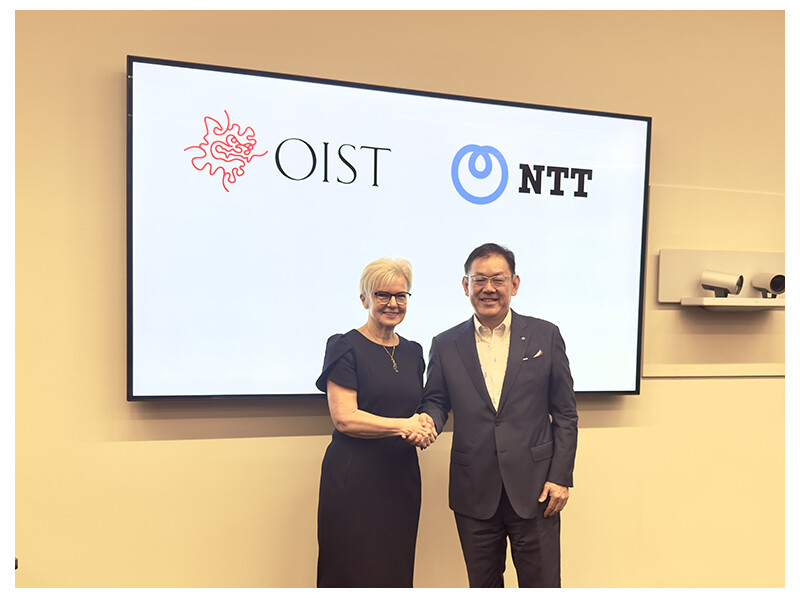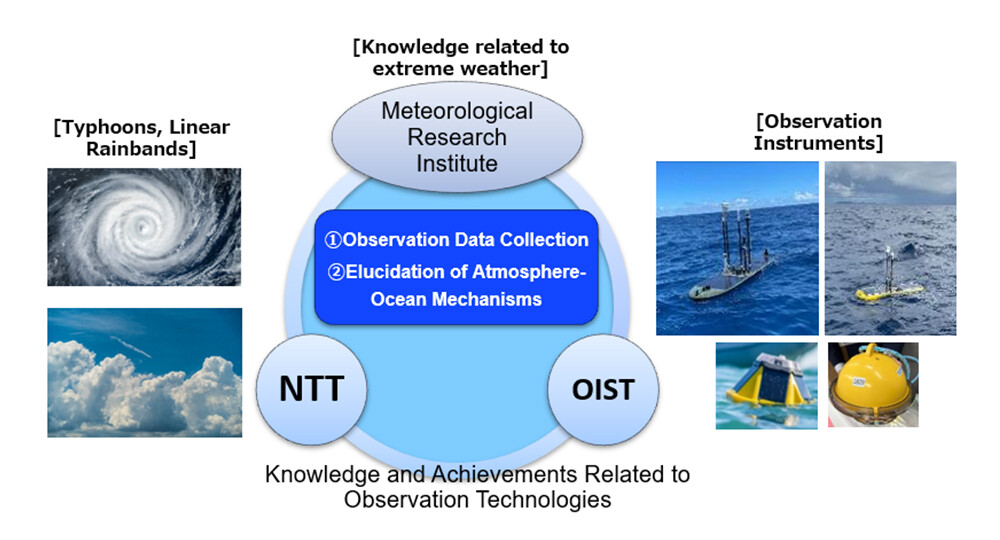Microsoft ends support for Internet Explorer on June 16, 2022.
We recommend using one of the browsers listed below.
- Microsoft Edge(Latest version)
- Mozilla Firefox(Latest version)
- Google Chrome(Latest version)
- Apple Safari(Latest version)
Please contact your browser provider for download and installation instructions.
June 3, 2025
Advancing the Understanding of Extreme Weather Through a New Research Collaboration
NTT and OIST to Launch Joint Initiative with Japan's Meteorological Research Institute to Improve Extreme Weather Forecasting
News Highlights:
- To better understand the mechanisms behind significant phenomena such as heavy rainfall associated with linear precipitation zones and typhoons—and to clarify the role of the ocean in the formation and development of extreme weather—NTT and OIST, which possess typhoon observation technologies and expertise in oceanic research, have entered into a joint research agreement with the Meteorological Research Institute (MRI), a leading authority in extreme weather research.
- The research will begin with the direct collection of marine meteorological and ocean surface data related to the formation and development of typhoons and linear precipitation zones—phenomena that are difficult to observe using current satellite-based remote sensing—with the goal of elucidating the atmospheric and oceanic mechanisms involved.
- By establishing a super-wide-area atmospheric and oceanic observation platform—crucial for Japan as a maritime nation—the collaboration aims to contribute to improving the accuracy of extreme weather forecasting.
TOKYO - June 3, 2025 - NTT (Headquarters: Chiyoda, Tokyo; President and CEO: Akira Shimada; hereinafter "NTT"), the Okinawa Institute of Science and Technology (Headquarters: Onna-son, Kunigami-gun, Okinawa; President and CEO: Karin Markides; hereinafter "OIST"), and the Meteorological Research Institute (Headquarters: Tsukuba, Ibaraki; hereinafter "MRI") have entered into a joint research agreement to conduct atmospheric and oceanic observations aimed at elucidating the mechanisms behind extreme weather events such as linear precipitation zones and typhoons.
As part of this collaboration, field observations will be carried out using autonomous unmanned marine vehicles1 capable of independent navigation and specialized observation buoys2 designed to collect meteorological and ocean surface data. These observations will be conducted during Japan's flood season3, when extreme weather events are most likely to occur. By leveraging the collected data, the project aims to advance the scientific understanding of the formation and development processes of linear precipitation zones and typhoons, ultimately contributing to improved forecasting accuracy and disaster preparedness.
 Dr. Karin Markides, President of OIST (left), and Dr. Katsuhiko Kawazoe, Senior Executive Vice President and CTO of NTT (right)
Dr. Karin Markides, President of OIST (left), and Dr. Katsuhiko Kawazoe, Senior Executive Vice President and CTO of NTT (right)
Background
In recent years, extreme weather events such as typhoons and torrential rains have become more frequent and intense, posing significant threats to society. Protecting lives and livelihoods from the disasters caused by these events is a pressing social challenge. To address this, NTT is conducting research aimed at minimizing the societal impact of natural disasters by enabling the accurate prediction of extreme weather and facilitating timely, preventive actions that also generate economic benefits.
While advancements in weather satellite technology have improved forecasting accuracy, further progress requires the direct collection of meteorological and ocean surface data—especially over the sea, where satellite-based observations remain limited. A deeper understanding of the atmospheric and oceanic mechanisms involved in the formation and development of typhoons and linear precipitation zones is essential.
Since fiscal year 2021, NTT and OIST have been engaged in joint research to advance atmospheric and oceanic observation methods, particularly in areas directly beneath typhoons, with the goal of improving extreme weather forecasting. Together, they have developed technologies to directly observe marine meteorological and ocean surface conditions near Okinawa, and have built a record of successful achievements4.
Meanwhile, the MRI plans to conduct intensive observations5 of both the atmosphere and ocean from late May through October 2025, to better understand the nature and mechanisms of significant weather phenomena such as linear precipitation zones and heavy rainfall associated with typhoons.
Details of the initiative
In this joint research effort, NTT and OIST—drawing on their expertise and experience in ocean-based typhoon observation—will collaborate with the MRI, which specializes in extreme weather phenomena. Together, they aim to collect direct observational data on events such as linear precipitation zones and typhoons, and use this data to elucidate the atmospheric and oceanic mechanisms behind these phenomena.
The key components of the initiative are as follows:
1. Collection of Marine Meteorological and Ocean Surface Data in Typhoon-Prone Areas
- Direct acquisition of atmospheric and ocean surface data during Japan's rainy season (June to September), when extreme weather events are most likely to occur.
- Deployment of observation instruments—including autonomous unmanned marine vehicles and buoys operated by each institution—in the waters surrounding the Islands of Okinawa to gather critical data (such as atmospheric pressure, temperature, and humidity) for the analysis of typhoons and linear precipitation zones.
- Utilization of NTT's communication and IoT sensing technologies to enable wide-area oceanic data collection across an extended range.
2. Elucidation of Atmospheric and Oceanic Mechanisms Behind Extreme Weather Events
- Fundamental analysis of sea surface observational data.
- Examination of ocean-atmosphere interactions based on sea surface data.
- Integrated analysis of atmospheric and oceanic interactions using both atmospheric data over ocean regions and ocean surface data.
 Figure 1Conceptual Image of the Initiative
Figure 1Conceptual Image of the Initiative
To understand the actual conditions and underlying mechanisms of linear precipitation zones, typhoons, and related phenomena, it is essential to directly observe lower atmospheric water vapor and sea surface temperatures in oceanic regions, where data is currently limited. The characteristics of significant weather events associated with linear precipitation zones and typhoons are highly diverse, with variations in their occurrence, causes, and typhoon tracks depending on each case. Therefore, it is necessary to collect and analyze observational data across a large number of cases. To address this, a four-year observational research program is planned to begin in fiscal year 2025, with the observation area and analysis scope to be gradually expanded each year.
From fiscal year 2025 to 2026, we will carry out the "Linear Precipitation Zone and Typhoon Sea Surface Observation Demonstration," collecting data using autonomous unmanned marine observation devices and observation buoys.
Beginning in fiscal year 2027, the scope of observation will expand from the sea surface to include the oceanic atmosphere (from the sea surface to the lower troposphere), under the newly titled "Linear Precipitation Zone and Typhoon Oceanic Atmosphere Observation Demonstration." This phase will incorporate atmospheric observation sensors alongside existing instruments to collect comprehensive atmospheric and oceanic data.
In parallel, we will advance research to improve forecasting technologies by conducting phased analyses aimed at elucidating the mechanisms driving atmospheric and oceanic processes.
 Figure 2Schedule
Figure 2Schedule
Future developments
Through this joint research, NTT and OIST will work in close collaboration with the Meteorological Research Institute to clarify the processes behind the occurrence and development of extreme weather events such as linear precipitation zones and typhoons. This will be achieved by directly collecting meteorological and ocean surface data in marine areas and utilizing this information to deepen our understanding of atmospheric and oceanic mechanisms. Additionally, the joint initiative aims to enhance the accuracy of forecasting such extreme weather events, thereby contributing to the realization of a society equipped with advanced disaster prevention systems.
NTT will further strengthen its collaboration with the Meteorological Research Institute and, through the development of a super-wide-area atmospheric and oceanic observation platform6, will contribute to improving the accuracy of extreme weather predictions. The initiative will also support the advancement of scientific understanding and academic research on atmospheric and oceanic systems.
Looking ahead, we will promote research into a global-scale atmospheric and oceanic IoT sensing infrastructure utilizing satellite IoT and High Altitude Platform Stations (HAPS), with the goal of establishing an ocean observation platform that is vital for Japan as a maritime nation.
Furthermore, we will pursue the development of application-specific technologies for high-precision prediction of extreme weather events7, leveraging a combination of global observational data and advanced simulation models.
Glossary
1Wave Glider (Liquid Robotics)
An autonomous surface vehicle that collects oceanographic data by harnessing wave energy.
https://www.liquid-robotics.com/wave-glider/how-it-works/
2Spotter Platform (SOFAR)
A buoy-based observation system that collects meteorological and oceanographic data.
https://www.sofarocean.com/products/spotter
3Flood season
The period during which river water levels are prone to rise due to factors such as rainfall and snowmelt.
4May 23, 2023: "NTT and OIST Make the First Simultaneous Atmospheric and Marine Observations Directly Beneath a Violent, Category 5 Typhoon in the North-West Pacific"
https://group.ntt/en/newsrelease/2023/05/23/230523a.html
5Fiscal Year 2025 Meteorological Research Institute Press Release
https://www.mri-jma.go.jp/Topics/R07/070528/070528_press.html
6Super-wide-area Atmosphere and Ocean Observation Technology (NTT Space Environment and Energy Laboratories)
https://www.rd.ntt/e/se/technology/iot_satellite.html
7Extreme Weather Forecasting Technology (NTT Space Environment and Energy Laboratories)
https://www.rd.ntt/e/se/technology/weather_forecast.html
About NTT
NTT contributes to a sustainable society through the power of innovation. We are a leading global technology company providing services to consumers and businesses as a mobile operator, infrastructure, networks, applications, and consulting provider. Our offerings include digital business consulting, managed application services, workplace and cloud solutions, data center and edge computing, all supported by our deep global industry expertise. We are over $90B in revenue and 340,000 employees, with $3B in annual R&D investments. Our operations span across 80+ countries and regions, allowing us to serve clients in over 190 of them. We serve over 75% of Fortune Global 100 companies, thousands of other enterprise and government clients and millions of consumers.
About OIST
OIST was founded in 2011 on the initiative of the Japanese government to contribute to global science and technology, attracting leading researchers from Japan and abroad to establish a world-class research hub and innovative knowledge cluster. As a pioneering graduate university, its mission is to conduct high-class research that bridges disciplines to explore new frontiers of scientific knowledge, educate a new generation of scientific leaders, and catalyze industrial innovation in Okinawa.
Media contact
NTT Information Network Laboratory Group
Inquiry Form
Okinawa Institute of Science and Technology
Media Relations Section
media@oist.jp
Information is current as of the date of issue of the individual press release.
Please be advised that information may be outdated after that point.
NTT STORY
WEB media that thinks about the future with NTT










